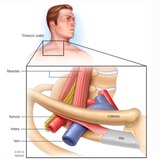
This week I had 3 very different cases of Thoracic Outlet Syndrome come into my office. I thought it would be worthwhile to discuss this condition in a little more detail. Let's give that a whirl!
When considering the thoracic out I think about 3 areas of concern:
- Neuro-vascular structures compromised: The brachial plexus, subclavian artery, and vein
- Bony entrapment sites: cervical ribs, between the 1st rib and clavicle, or coracoid process
- Soft tissue entrapment sites: between the scales and/or pectoralis minor
I then review the symptoms with the patient and their presentation.

Shop our kinesiology tape now
Shop Now
Common things I see and hear are:
- My whole hand (or 4th/5th digit) goes numb while sleeping while riding my bike, or swimming
- I get the feeling as though I’m wearing a sock around my arm (think arterial entrapment in scalenes or between the 1st rib and clavicle)
- I get discoloration in my arm and hand, especially during exercise (think arterial entrapment in scalenes or between the 1st rib and clavicle)
- I get swelling in my hand (think venous entrapment in pectorals minor)
- A decrease in the strength of (not the rate) the radial pulse when performing any of the many tests for thoracic outlet
- A classic “Upper Cross Syndrome” posture, where the primary issue can lie in the neck, shoulder, mid-back, or a combination of them all. For this reason, visit a skilled clinician for proper evaluation
From there I develop a treatment plan centered around reducing symptoms and maximizing the space through the thoracic outlet.

Shop our bundles now
Shop Now
This usually encompasses some or all of the following:
- Improving tissue quality and tone through the chest and muscles of secondary respiration
- Improving upper thoracic and rib mobility
- Improving lower cervical spine stability
- Improving shoulder reactivity and peri-scapular stability
The reality is thoracic outlet syndrome is tricky. Often patients go months without a correct medical diagnosis largely due to the fact that symptoms are absent during testing. In my experience a doppler ultrasound, while symptomatic, along with EMG can help solidify a proper diagnosis and prognosis for the patient.
I hope this article has given you a few quick pointers when it comes to this very common condition.
Are you someone that suffers from thoracic outlet syndrome? Are you a clinician that treats?
As always we’d love to hear your thoughts!
If you want to read up on different aches and pains, check out the Tape Geeks blog! Learn more about kinesiology taping as well.

Shop our collection now
Shop NowSubscribe to the TapeGeeks Newsletter for new videos, discounts and more!Join The Geeks Club









